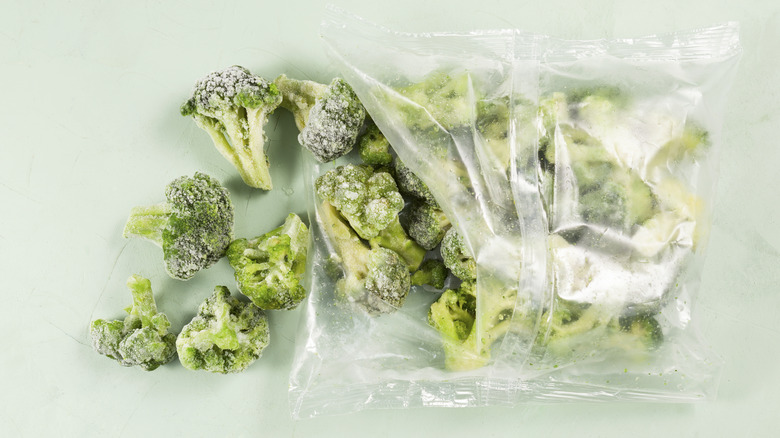The Smartest Way To Store Broccoli In Your Fridge
Although we generally think of broccoli as a hardy vegetable, it can go bad surprisingly fast, and soggy, bendy stems and yellow florets are a sad sight indeed. To make this cruciferous veggie last longer, the best storage method (albeit the strangest) is to treat your raw broccoli like a bouquet of flowers.
First of all, avoid washing your broccoli until right before you're going to eat it, as extra moisture left behind on the veggie can hasten spoilage. Instead, pour about half an inch of water into a container, jar, or small vase, and place the broccoli inside with its stem down. The florets should be entirely out of the water, and you can loosely cover them with plastic wrap to protect them, while still allowing airflow. Just like cut flowers do, your broccoli will retain its moisture using the source of water, which is key to keeping it fresh and crisp.
Store your bouquet of broccoli in the fridge, replacing the water each day to keep it in top shape. While broccoli might last only a few days when simply thrown into the fridge, the bouquet method will keep your heads or florets fresh for at least a week. Just like that, you've got longer-lasting broccoli that's ready to use any time you're craving broccoli cheddar soup, roasted broccoli, or chicken and broccoli linguine.
Other ways to store broccoli in the fridge
The bouquet method of storing broccoli is effective, but somewhat high-maintenance with the need for daily water changes. Not everyone has fridge shelves tall enough to house jars or vases full of veggies, either. To simplify broccoli storage, one option is to wrap your entire piece of broccoli loosely in plastic wrap, aluminum foil, or paper towels. Each of these materials allows for some airflow, which is crucial for releasing broccoli's ethylene gasses. This type of gas can ripen and then rot produce through long-term exposure.
Even with sufficient airflow, the florets will only last a few days using this method. Your broccoli will go bad even sooner if you make the storage mistake of placing it near other ethylene-producing fruits and veggies, or if you wash it prior to refrigerating. The only exception to the no-washing rule is with pre-cut broccoli, which is okay to rinse before storage, but you should still do your best to dry it thoroughly.
After washing and drying cut broccoli, place it an airtight container lined with paper towels to absorb any remaining water. Again, this method only gives your broccoli a few days of shelf life, so if you've bought a ton or want to keep it around for longer, your best bet is to just take the bouquet route.
Freeze broccoli for long-term storage
When you know you can't use up all your broccoli within a week, the best move is to freeze the veggies. First, you'll need to blanch the broccoli florets by boiling them for just a minute or two, then cool the florets in an ice bath. This process not only preserves broccoli's nutrients, but actually increases the amount of certain vitamins in the veggie, making frozen broccoli more nutritious than fresh.
After the broccoli has cooled, dry the pieces as much as possible to limit the formation of ice crystals later on. Next, lay the broccoli out on a sheet tray and freeze for a few hours. At this point, you can store all the florets together in a container or zip-top bag, laying the food flat for optimal storage. Ideally, you should use frozen broccoli within six to eight months, but it should last up to a year before its quality starts to suffer noticeably. What an excellent way to store a bountiful broccoli crop from your garden!



